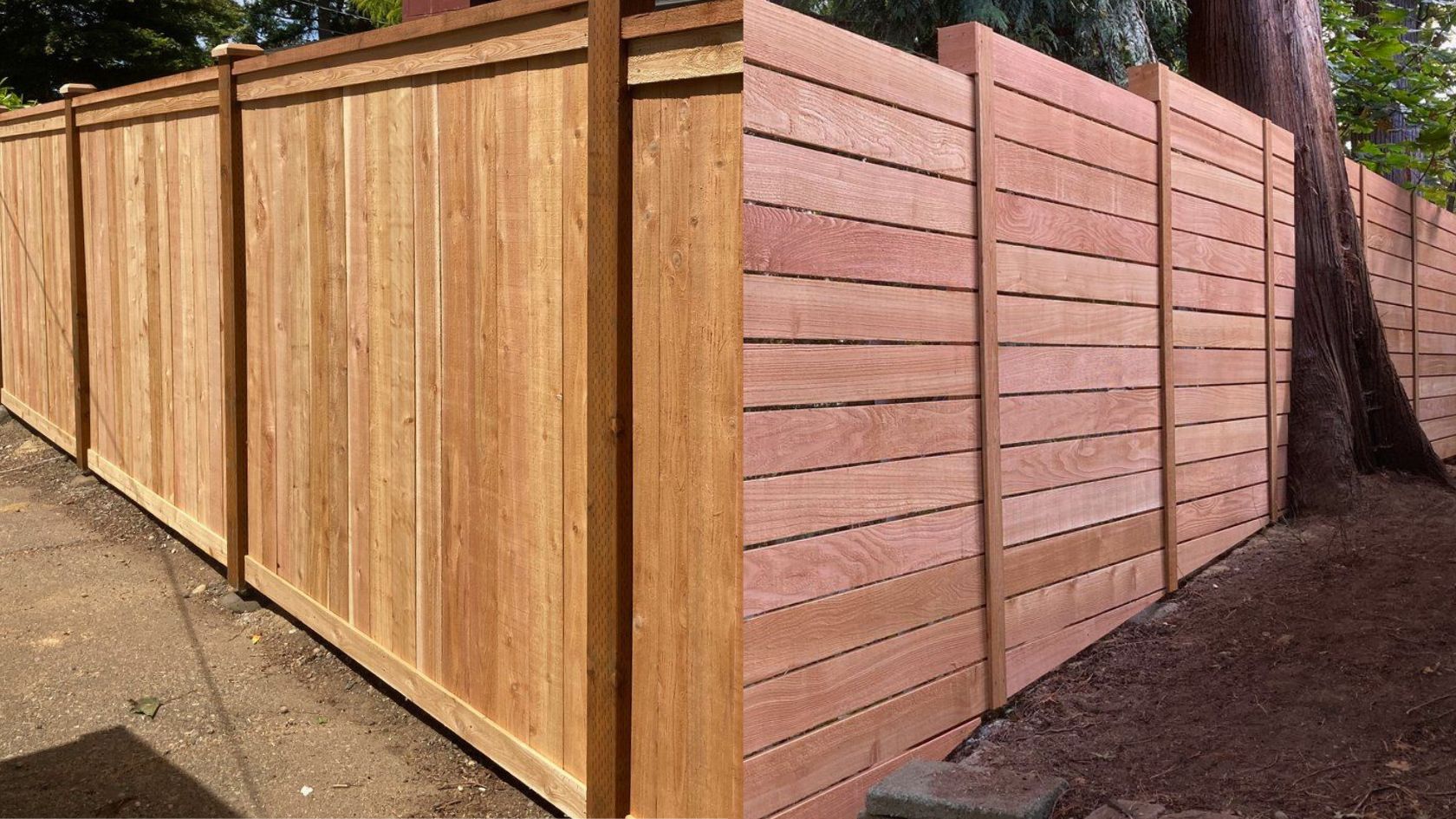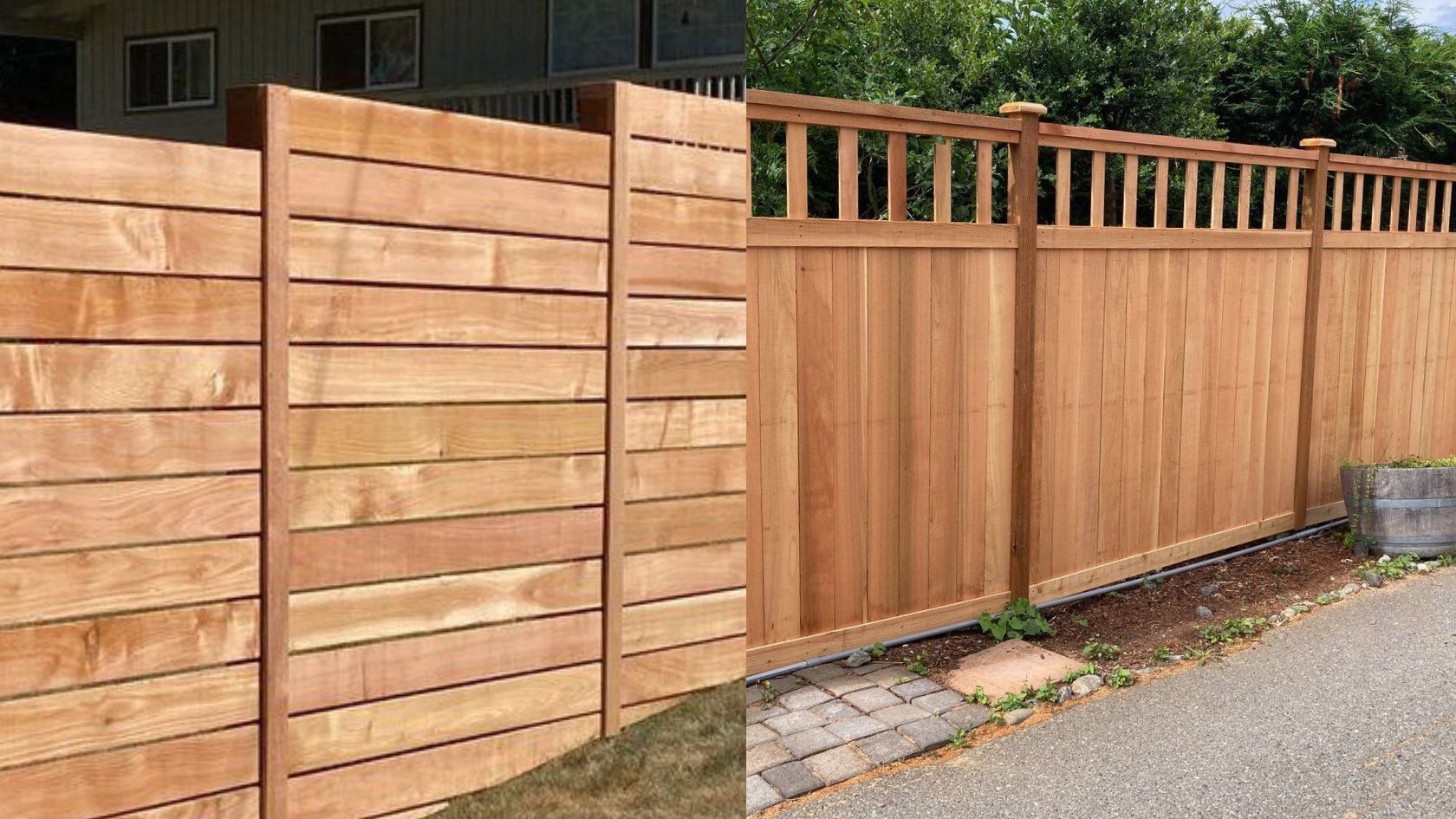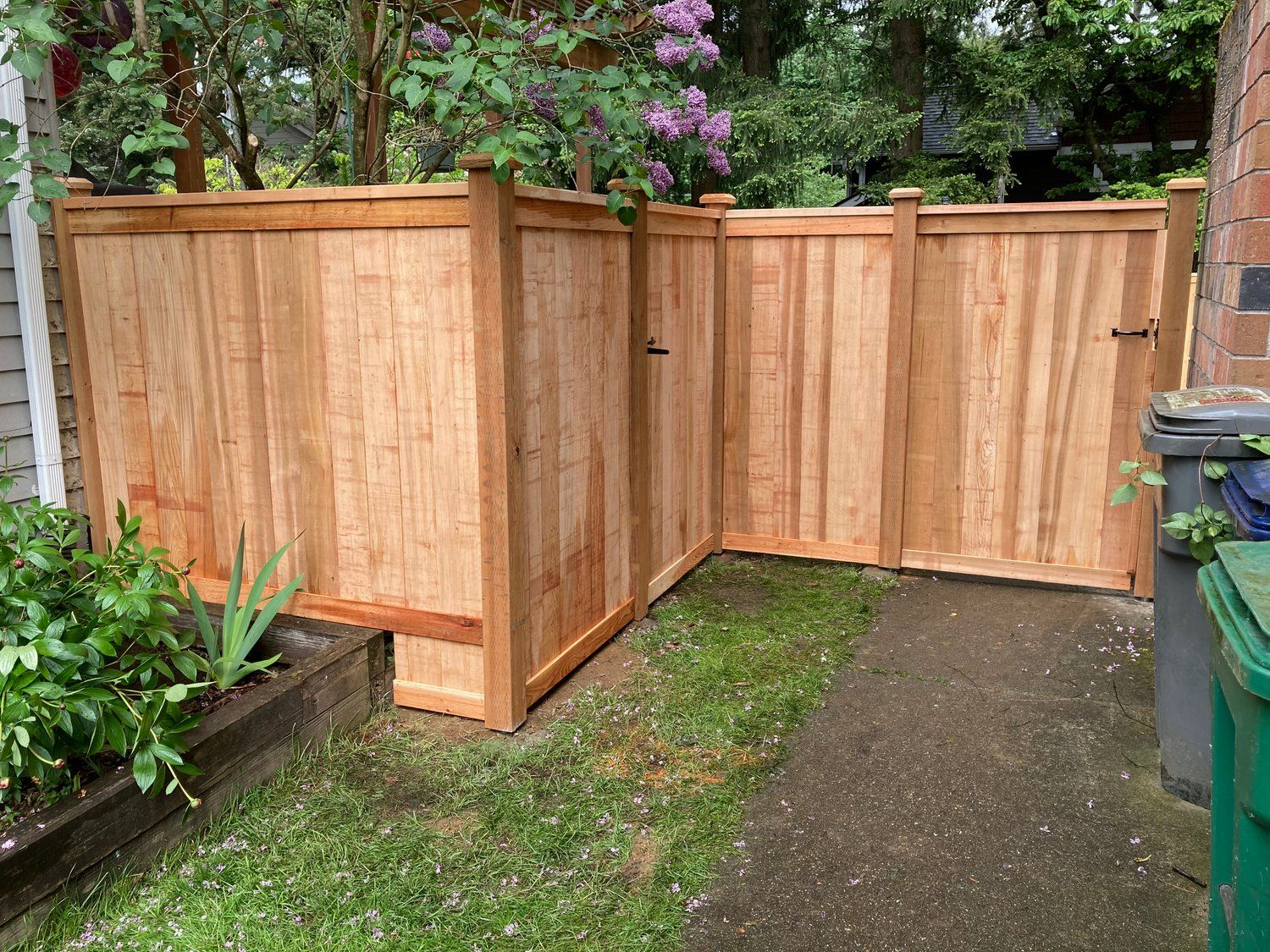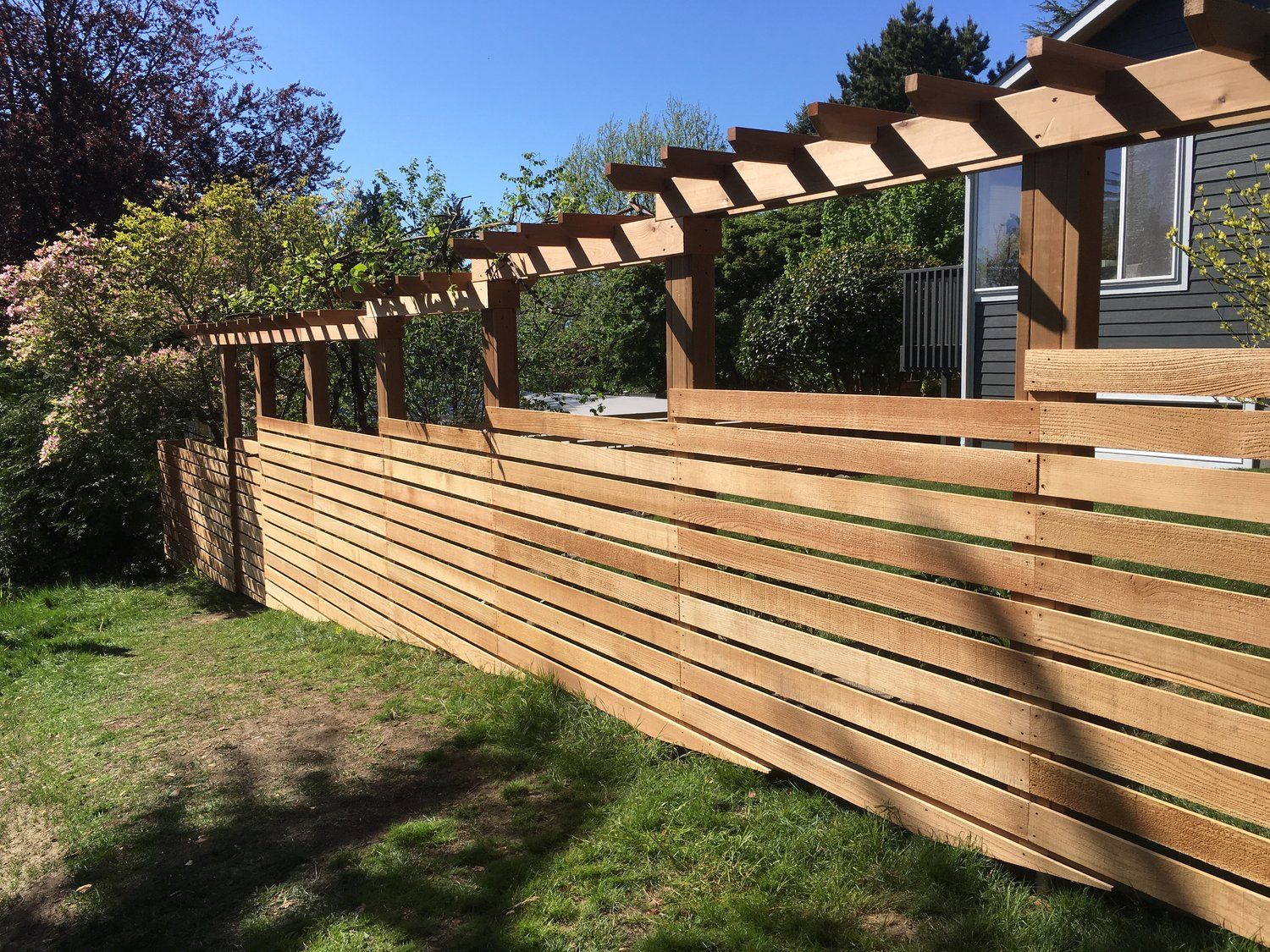Debating a horizontal or vertical fence for your home? This article covers everything from costs and installation to aesthetics to help you decide which is right for you.
Key Takeaways
- Horizontal fences offer a sleek, modern look but are more expensive and challenging to install, while vertical fences are more traditional, cost-effective, and better for uneven terrain.
- The primary benefits of horizontal fences include making spaces appear larger and enhancing contemporary home aesthetics, while vertical fences offer superior privacy and security with a classic charm.
- When choosing between horizontal and vertical fences, consider factors such as property terrain, budget, privacy needs, installation complexity, and the overall architectural style of your home.
Understanding Horizontal and Vertical Fences
Horizontal and vertical fences serve the same primary purpose but differ significantly in design, installation, and maintenance. Horizontal fences feature pickets running parallel to the ground, creating a sleek, modern look. In contrast, vertical fences have boards running from the ground up, offering a more traditional appearance.
One of the main differences lies in flexibility and cost. Horizontal fences often require higher-grade lumber and closer post spacing to prevent sagging, making them more expensive and less flexible to install. On the other hand, vertical fences are more adaptable to various terrains and are typically cheaper to install due to the use of less expensive materials.
The choice between horizontal and vertical fences also depends on the specific needs of your property. While horizontal fences provide a modern aesthetic and can make spaces appear larger, vertical fences are better suited for traditional homes and sloped or uneven landscapes. Appreciating these fundamental differences will aid you in making a decision that suits your tastes and property needs.
Style and Aesthetics
The choice of a fence is significantly influenced by style and aesthetics. Horizontal fences are celebrated for their modern, clean lines that enhance contemporary architectural styles. They add a touch of sophistication and visual interest to any property, making them a popular choice for modern homes.
Conversely, vertical fences offer a traditional look that complements classic home designs. This type of fencing adds a timeless charm and can blend seamlessly with older architectural styles, providing a cohesive and visually pleasing appearance.
Modern vs. Traditional
Modern and traditional fence styles have clearly marked differences. Some characteristics of modern fences include:
- Sleek and minimalist design
- Horizontal orientation
- Emphasis on clean lines and minimalism
- Ideal for contemporary homes
- Enhances the overall architectural style of the property
On the other hand, vertical fences are synonymous with a traditional look. Think of the classic white picket fence that graces many traditional homes. This style emphasizes a sense of nostalgia and can perfectly complement colonial or classic home designs.
Visual Impact
By making properties seem more extensive, horizontal fences can significantly impact the visual appeal. Their clean lines and horizontal design help elongate the space, giving an illusion of a more expansive property. This effect is particularly beneficial for modern homes looking to enhance curb appeal and visual interest.
Vertical fences, in contrast, emphasize height and openness. They create an illusion of taller structures and can make a home appear more stately and grand. This classic charm is perfect for properties that want to maintain a traditional look while ensuring a sense of openness and height.
Structural Considerations
From a structural perspective, horizontal fences typically demand superior grade lumber and additional reinforcement to avoid sagging. This need for robust materials and closer post spacing makes horizontal fences more expensive to install and maintain.
Vertical fences, on the other hand, often use less expensive materials and are easier to install on uneven terrain. The weight of the fence panels is evenly distributed, reducing the risk of structural issues over time. Recognizing these structural variances is key to making a well-informed decision that accommodates your property's unique needs and landscape.
Level Ground vs. Sloped Ground
Horizontal fences are best suited for level ground due to their design requirements. Installing them on uneven terrain can be challenging and may require additional reinforcement to ensure stability. This makes them ideal for properties with a flat landscape where their clean lines can be fully appreciated.
Vertical fences, however, excel on sloped or uneven ground. They can be staggered or stair-stepped to follow the natural contour of the land, ensuring a consistent and visually appealing fence line. This adaptability makes vertical fences a practical choice for properties with varied terrains.
Durability and Maintenance
Both horizontal and vertical fences come with separate concerns regarding durability. Horizontal fences, though typically made from higher-grade lumber, are prone to sagging if not properly reinforced. Regular maintenance, including ensuring proper reinforcement and addressing any sagging issues promptly, is essential to keep them in good shape.
Vertical fences, while generally more structurally sound, can be susceptible to rotting, especially if the end grain of the wood is exposed to moisture. Proper treatment and regular maintenance, such as refinishing and protecting the wood, are crucial to increase their longevity and maintain their appearance.
Installation Process
There is a significant variance in the installation process for horizontal and vertical fences. Vertical fences are often more DIY-friendly due to the availability of pre-built panels. These panels make the installation process quicker and more manageable for homeowners.
Horizontal fences, however, require precise leveling and higher quality materials to prevent sagging, making them more challenging for DIY projects. Professional installation is usually recommended to ensure a sturdy and visually appealing final product.
DIY vs. Professional Installation
A DIY fence project is particularly suitable for vertical fences. The availability of pre-built panels simplifies the installation process, making it feasible for homeowners to tackle the project themselves. If you have basic carpentry skills and the necessary tools, installing a vertical fence can be a rewarding and cost-effective DIY endeavor.
Conversely, horizontal fences carry more complexity and usually necessitate professional installation. The need for precise leveling and high-quality materials to avoid sagging makes it a job best left to experienced fence installers. Hiring a professional ensures that the fence is built to last and looks great.
Labor and Material Costs
Horizontal fences are generally more expensive to install due to the need for higher-quality materials and closer post spacing. The cost of labor is also higher because of the complexity of the installation process. These factors can make horizontal fences around 10-20% more expensive than vertical ones.
Vertical fences have several advantages:
- They are considered more cost-effective due to the use of less expensive wood.
- They can be pre-assembled off-site for added convenience, reducing both material and labor costs.
- They are a budget-friendly option for homeowners.
Privacy and Security
When selecting a fence, privacy and security are vital factors to consider. Horizontal fences can provide varying levels of privacy by adjusting the spacing between the boards. This flexibility allows homeowners to customize their fences to meet their privacy needs while maintaining a modern aesthetic.
Vertical fencing, including wire fence options, is a popular choice among homeowners, as vertical fences tend to offer better privacy and security due to the closer placement of the fence boards. This design makes it more challenging for intruders to climb over and peep through, ensuring a higher level of security for your property.
Privacy Levels
Vertical fences provide superior privacy compared to horizontal fences. The boards in vertical fences are placed closer together, effectively blocking views from outside and ensuring maximum privacy for homeowners.
Horizontal fences, such as a horizontal wood fence, can also offer good privacy, but it depends on the spacing between the horizontal boards. Adjusting the gaps can help achieve the desired level of privacy while maintaining a stylish look with horizontal fencing.
Security Features
When it comes to security, vertical fences have the upper hand. Their design makes them more difficult to climb, providing an additional layer of protection for your property. This feature is particularly important for families with children or pets who need a secure outdoor space.
Horizontal fences, while stylish and modern, may not offer the same level of security as their vertical counterparts. However, adding features like lattice tops or security cameras can enhance their security capabilities.
Enhancing Property Value
A significant boost to your property's value and curb appeal can be achieved by installing a fence. Some benefits of horizontal fences include:
- Modern and attractive design
- Makes your home stand out in the neighborhood
- Potential increase in market value
- Better return on investment (ROI) compared to vertical fences
The unique look and higher-quality materials used in horizontal fences, including horizontal stringers, often result in these benefits.
Vertical fences, while not as visually striking as horizontal ones, maintain a classic charm that appeals to many homebuyers. Their traditional look and cost-effectiveness can still contribute positively to your property's value.
Environmental Impact
For eco-conscious homeowners, it's vital to contemplate the environmental impact of their chosen fencing materials. Opting for wooden fences like cedar is an eco-friendly choice due to their renewable nature and lower carbon footprint compared to plastic or metal. Bamboo fencing is another sustainable option, as bamboo grows rapidly and regenerates quickly.
Biocomposite fences, made from recycled plastic and natural wheat straw, combine durability with eco-friendliness. Choosing sustainable materials not only reduces your environmental footprint but also supports eco-friendly practices.
Best Materials for Fencing
A multitude of options are available to consider when it comes to fencing materials. Wood remains the most popular choice for its natural beauty and versatility, often used in constructing a wooden fence. Common types include cedar and redwood, known for their durability and resistance to warping. Bamboo is also a strong and cost-effective alternative to traditional wood.
Some popular types of fencing include:
- Vinyl fencing: offers durability and low maintenance but can warp or crack in extreme temperatures
- Wrought iron and aluminum fences: add elegance to a property while being low-maintenance
- Chain-link fencing: an affordable and durable option for homeowners on a budget
Practical Tips for Choosing Your Fence
The selection of the right fence involves the consideration of various practical aspects. Here are some steps to follow:
- Determine the purpose of the fence, whether for privacy, aesthetics, or containment.
- Set a budget, as fencing materials vary widely in cost.
- Check with your homeowner's association (HOA) to ensure compliance with neighborhood standards.
Finding your exact property line is essential to avoid disputes with neighbors. Harmonizing the fence with your home's architectural style creates a cohesive look, while considering the local climate can impact the fence's durability and maintenance needs.
Matching Fence to Home Style
The architectural style of your home should be complemented by the fence. For historic homes, a wrought iron fence can add elegance and maintain the property's classic charm. Vinyl fences come in various styles and colors, making them suitable for modern homes.
Modern homes often benefit from minimalist horizontal slat fences, while colonial-style homes are well complemented by classic picket fences.
Considering Local Climate
Your decision between horizontal and vertical fences should be influenced by the local climate. Vertical fences are more susceptible to wear in high humidity or frequent rainfall areas, as the ends of the boards are exposed to moisture. Horizontal fences, with their end configuration, may offer better weather resistance in such environments.
Considering weather resistance can significantly guide your decision, ensuring the fence you choose will withstand local climate conditions and last for years to come.
Summary
Choosing between horizontal and vertical fences depends on various factors, including aesthetic preferences, structural considerations, and budget. Horizontal fences offer a modern look and enhance property value, while vertical fences provide traditional charm and better adaptability to uneven terrain. Both types have unique benefits and maintenance needs.
Ultimately, the best fence for your home is one that meets your specific requirements and complements your property's style. Whether you opt for the sleek lines of a horizontal fence or the classic appeal of a vertical fence, making an informed choice will ensure you enjoy both beauty and functionality for years to come.
Frequently Asked Questions
Which type of fence is more cost-effective?
Vertical fences are more cost-effective than horizontal fences because they use less expensive materials and can include pre-built panels, reducing labor costs.
Are horizontal fences more difficult to install?
Yes, horizontal fences are typically more difficult to install than vertical ones due to the need for precise leveling and higher quality materials to prevent sagging. It's often recommended to seek professional expertise for installation.
What type of fence offers better privacy?
Vertical fences offer better privacy because the closer placement of the boards effectively blocks views from outside.
How do horizontal and vertical fences impact property value?
Horizontal fences can enhance property value with their modern and attractive design, while vertical fences maintain a classic charm that also appeals to many homebuyers. Both types can positively impact property value.
What are some eco-friendly fencing material options?
Consider using eco-friendly fencing materials such as cedar, bamboo, and biocomposite, which are renewable resources with lower carbon footprints, regenerate quickly, and utilize recycled materials. Choose the option that best fits your needs and values.








